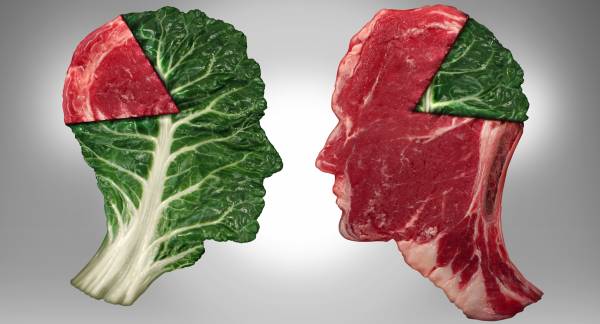DOES ORGANIC REALLY MATTER? HOW TO RANK NUTRITIONAL PRIORITIES
What is the perfect diet? This is the question that blows up Internet forums. Researchers and trolls alike debate this question with a beautiful blend of science, opinion, anger, humor, and everything in between. (I’ve always argued a paleo vegan diet is what we need to thrive.)
Two Guiding Principles
I don’t actually have an answer to the perfect diet question, but I do have priorities and principles. I believe that for a long-term approach, the food we eat must do two things:
- Have enough protein to build or maintain muscle tissue.
- Have enough vitamins and minerals to help us thrive instead of just survive.
If you can accomplish those two things, you’ll be ahead of most people. You can add to that list, but for most goals those two things comprise 90% of the battle. Whether you’re after muscle gain or fat loss, you only need to tweak the other 10%. Given that our aging population suffers from strength loss and malnutrition, these principles also hold up for long-term health and aging.
How to Rank Priorities
Where most people go wrong is getting their priorities mixed up. We worry about the 10% and not the important 90%. It kills me when a fat-loss client calls me frustrated they aren’t losing weight even though they are eating organic foods. It’s as if organic foods defy the laws of thermodynamics.
To hit adequate protein levels and to make sure we are getting as much vitamins and minerals as we can, we must rank what is actually important. When looking at each food group, we want to know which source provides the most nutrients per unit. I also factor in cost-to-benefit ratio.
“It kills me when a fat-loss client calls me frustrated they aren’t losing weight even though they are eating organic foods. It’s as if organic foods defy the laws of thermodynamics.”
Instead of discussing theory, let’s take a look at it as if you were standing in a supermarket. We’ll rank our priorities in each category of food from what we need to worry about first.
Fruits and Vegetables
- Actually eating fruits and vegetables – Try to get at least three different types per day.
- Local, in season – The best option for high-nutrient content at reasonable cost.
- Frozen – Frozen when ripe, and you can buy them in bulk without spoilage.
- Conventionally grown – Wash and enjoy. Not perfect but you could do worse.
- Canned – Contain less nutrients, and be sure to get BPA-free cans.
- Going organic – Large cost, “natural” pesticides still exist, and studies are inconclusive about whether they are harmful. It’s a personal decision, but not vital to success.
Seafood
- Fresh – Nothing beats fresh seafood for taste and safety.
- Frozen fresh – The next best thing as the fish is often frozen on the boat.
- Wild – Will offer the most wholesome food, but beware of sustainability issues.
- Farm raised – Nutrients vary depending on feed and may be environmentally damaging.
Meat and Poultry
- Getting a variety – Regardless of the source, this is the most important thing.
- Locally sourced – Knowing where your meat comes from helps ensure it is fresh.
- Pasture-raised or grass-fed – These are decisions based on environment, treatment of animals, and perhaps more nutrients without toxins. Extremely costly, but may be worth it to you.
Dairy and Eggs
- Cheese, eggs, and Greek yogurt – Protein, protein, protein, and some good fat to go with it.
- Milk (if desired) – Not essential, but depending on your other choices, it can be a good nutrient source.
- Local products – Always your best bet for freshness and nutrient density.
- Grass-fed dairy – The health benefits versus the cost may not be worth it.
- Pastured eggs – Dark yellow yolks mean more vitamins, but may be over five dollars per carton.
Carbohydrates
- Sweet potato, quinoa, rice, oats – Carbohydrates packed with vitamins and minerals. Trying to get the most nutrients out of your carbohydrates is a top priority.
- Whole grain versus refined bread and pastas – Is there a huge difference? Not really. This decision isn’t a game changer as some will have you believe.
Your list may be ordered a bit differently. But my point is, if you take the top of each list: fruits, vegetables, fresh seafood, and a variety of meats, cheese, eggs, yogurt, quinoa, and sweet potato, that’s a great diet. Only worry about doing more if you already have these habits in place.
“Don’t be that person eating a grass-fed steak with a Diet Coke and fries. Let’s get the basic foundation of a diet down before we do more.”
Studies are mixed on whether organic, wild, and grass-fed sources have more nutrients per unit. And even if they do have more nutrients, is it worth the high cost? Those are personal choices, of course. But also factor in whether those costs are sustainable for you long term.
Start With the Basics
Don’t be that person eating a grass-fed steak with a Diet Coke and fries. Let’s get the basic foundation of a diet down before we do more. My wife and I are satisfied with where our food comes from. We’ve made decisions based on cost and figured out what works best for us long term. We decided there are avenues other than our food that would reduce our exposure to chemicals, like having natural cleaners and soaps.
There are always ways to be healthier, but it doesn’t have to be from food. Make sure you are getting your basic needs for long-term health first.
Photos courtesy of Shutterstock.

